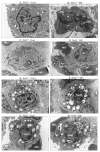Nrf2 Lowers the Risk of Lung Injury via Modulating the Airway Innate Immune Response Induced by Diesel Exhaust in Mice
- PMID: 33096811
- PMCID: PMC7589508
- DOI: 10.3390/biomedicines8100443
Nrf2 Lowers the Risk of Lung Injury via Modulating the Airway Innate Immune Response Induced by Diesel Exhaust in Mice
Abstract
In the present study, we investigated the role of Nrf2 in airway immune responses induced by diesel exhaust (DE) inhalation in mice. C57BL/6J Nrf2+/+ and Nrf2-/- mice were exposed to DE or clean air for 8 h/day and 6 days/week for 4 weeks. After DE exposure, the number of neutrophils and macrophage inflammatory protein (MIP)-2 level in bronchoalveolar lavage fluid (BALF) and interleukin (IL)-17 level in the lung tissue increased in Nrf2-/- mice compared with Nrf2+/+ mice; however, the lack of an increase in the level of tumor necrosis factor (TNF)-α in the lung tissue in Nrf2+/+ mice and mild suppression of the level of TNF-α in Nrf2-/- mice were observed; the level of granulocyte macrophage colony-stimulating factor (GM-CSF) in the lung tissue decreased in Nrf2-/- mice than in Nrf2+/+ mice; the number of DE particle-laden alveolar macrophages in BALF were larger in Nrf2-/- mice than in Nrf2+/+ mice. The results of electron microscope observations showed alveolar type II cell injury and degeneration of the lamellar body after DE exposure in Nrf2-/- mice. Antioxidant enzyme NAD(P)H quinone dehydrogenase (NQO)1 mRNA expression level was higher in Nrf2+/+ mice than in Nrf2-/- mice after DE exposure. Our results suggested that Nrf2 reduces the risk of pulmonary disease via modulating the airway innate immune response caused by DE in mice.
Keywords: immune response; lung diseases; macrophage; neutrophils; oxidative stress/anti-oxidative stress.
Conflict of interest statement
The authors declare that they have no conflict of interest.
Figures







Similar articles
-
Nrf2 Regulates the Risk of a Diesel Exhaust Inhalation-Induced Immune Response during Bleomycin Lung Injury and Fibrosis in Mice.Int J Mol Sci. 2017 Mar 17;18(3):649. doi: 10.3390/ijms18030649. Int J Mol Sci. 2017. PMID: 28304344 Free PMC article.
-
Part 1. Assessment of carcinogenicity and biologic responses in rats after lifetime inhalation of new-technology diesel exhaust in the ACES bioassay.Res Rep Health Eff Inst. 2015 Jan;(184):9-44; discussion 141-71. Res Rep Health Eff Inst. 2015. PMID: 25842615
-
Inhalation of diesel exhaust enhances allergen-related eosinophil recruitment and airway hyperresponsiveness in mice.Toxicol Appl Pharmacol. 1998 Jun;150(2):328-37. doi: 10.1006/taap.1998.8437. Toxicol Appl Pharmacol. 1998. PMID: 9653064
-
Inflammatory and functional responses after (bio)diesel exhaust exposure in allergic sensitized mice. A comparison between diesel and biodiesel.Environ Pollut. 2019 Oct;253:667-679. doi: 10.1016/j.envpol.2019.06.085. Epub 2019 Jul 5. Environ Pollut. 2019. PMID: 31330358
-
Role of Nrf2 in inflammatory response in lung of mice exposed to zinc oxide nanoparticles.Part Fibre Toxicol. 2019 Dec 16;16(1):47. doi: 10.1186/s12989-019-0328-y. Part Fibre Toxicol. 2019. PMID: 31842927 Free PMC article.
Cited by
-
Potential of NRF2 Pathway in Preventing Developmental and Reproductive Toxicity of Fine Particles.Front Toxicol. 2021 Sep 13;3:710225. doi: 10.3389/ftox.2021.710225. eCollection 2021. Front Toxicol. 2021. PMID: 35295150 Free PMC article.
References
-
- Li Y.J., Umezawa M., Takizawa H., Takeda K., Kawada T. PM2.5: Role of Oxidative Stress in Health Effects and Prevention Strategy. Nova Science Publishers; New York, NY, USA: 2015.
LinkOut - more resources
Full Text Sources
Other Literature Sources
Molecular Biology Databases
Research Materials
Miscellaneous

